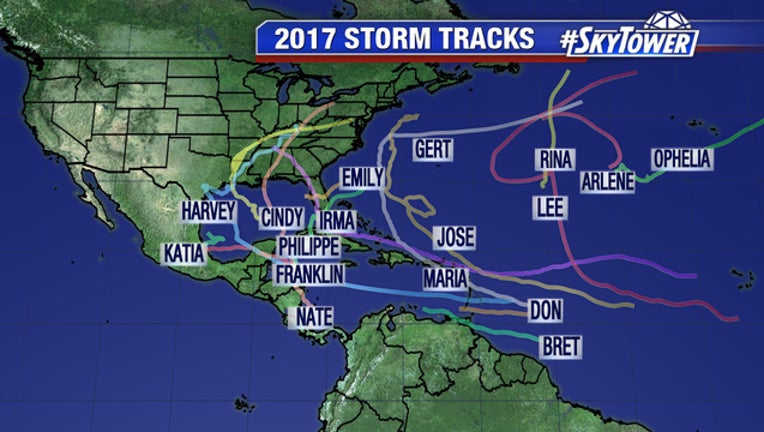Hurricane names Harvey, Irma, Maria and Nate will retire

TAMPA (FOX 13) - The World Meteorological Organization maintains a six-list rotation of storm names for the Atlantic Basin. So, if you see a name that you think you’ve heard before, you probably have. However, whenever a storm is particularly destructive or deadly -- so much so that the future use of that name would be insensitive -- it is retired forever.
Four names from the 2017 Atlantic Hurricane Season – Harvey, Irma, Maria, and Nate – will never be used again. Taking their place will be Harold, Idalia, Margot, and Nigel respectively. These names will first appear during the 2023 season.
This is the second-most names ever retired in a single year. The 2005 season still holds the top spot with five retirees (Dennis, Katrina, Rita, Stan, and Wilma). Since we began naming storms back in 1953, there have now been 86 names retired.
Below you’ll find a recap from the National Hurricane Center of the four retired storms from 2017. A full review of the 2017 season can be found here.
Hurricane Harvey became a Category 4 hurricane on the Saffir-Simpson scale before making landfall along the middle Texas coast on Aug. 25. The storm then stalled, with its center remaining over or near the Texas coast for four days, dropping historic rainfall amounts, of up to 5 feet, causing catastrophic flooding in parts of southeastern Texas. Harvey is the second-costliest hurricane in U.S. history (after inflation), behind only Katrina in 2005. At least 68 people died from the direct effects of the storm in Texas, the largest number in that state since 1919.
%INLINE%
Hurricane Irma was a long-lived hurricane that reached Category 5 intensity on Sept. 5. The catastrophic hurricane made seven landfalls, four of which occurred as a Category 5 hurricane across the northern Caribbean Islands. Irma made landfall as a Category 4 hurricane in the Florida Keys on Sept. 10 and struck southwestern Florida as a Category 3 the same day. Irma caused 44 direct deaths as a result of its strong winds, heavy rain and high surf. In the U.S., seven direct deaths were reported, and an additional 85 indirect deaths occurred, 80 of which were in Florida. Hundreds more were injured preparing for the storm, during it, or in its aftermath.
Hurricane Maria ravaged the island of Dominica as a Category 5 on Sept. 19, and later devastated Puerto Rico as a high-end Category 4 hurricane. It also inflicted serious damage on some of the other islands of the northeastern Caribbean Sea. Maria is the third-costliest hurricane in U.S. history, behind Harvey and Katrina. Maria caused 31 direct deaths with 34 missing in Dominica, and two direct deaths in Guadeloupe. In Puerto Rico, the death toll stands at 65, plus an unknown number of indirect deaths.
Hurricane Nate crossed northeastern Nicaragua and eastern Honduras as a tropical storm, then made landfall on the northern Gulf Coast as a Category 1 hurricane. It brought rainfall that caused significant impacts in Central America, where media reports indicate that these caused 44 deaths in the region. An additional fatality in Panama was due to a “shipwreck,” bringing the death toll directly associated with Nate to 45. An additional nine people were missing in the region.

